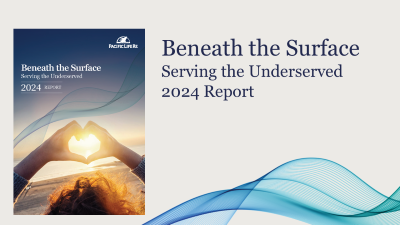Mike Wilson | 31 October 2024
Recent months have seen further successive waves of Covid-19 across many countries, including the UK, US, Canada and Australia. This includes a relatively large wave in July and August, which has since subsided. Several Olympic athletes withdrew from events due to infections, or later admitted to having Covid. This wave caused age-standardised mortality rates in the UK for 2024 to diverge from those of 2019 (see the yellow line in the diagram below), which is the best year on record [1].

Since that time, it has become clear that the remainder of this year more closely tracks 2019 than 2022 (red line), in which the whole second half of the year saw relatively poor mortality. This is fairly good news, and we expect mortality has broadly recovered to around pre-pandemic levels everywhere, though note that no improvements over a period of five years is a poor outcome compared to long-term trends. The effects of the tail end of the pandemic contribute to this, as do relatively weak improvement rates more generally.
The variants of COVID-19 involved in recent waves appear of similar severity to those prevalent throughout the last two years, as do those which have emerged more recently. Mortality impacts in the general population are especially noticeable on a baseline of typically low summer mortality in the northern hemisphere but are far smaller than during 2020-2022.
In England, useful data emerged estimating the current risks associated with an infection. Between November 2023 and March 2024 the Winter Coronavirus Infection Study tested a sample of the population to determine COVID-19 incidence and prevalence and also recorded hospitalisations and mortality associated with the virus. The risks associated with COVID-19 remain highly age-dependent and are shown below. These have fallen roughly 90% since early in the pandemic and are now broadly comparable to death rates from influenza. COVID-19 still infects people around three times more regularly than ‘flu, so retains a higher overall burden on health.[2]

We can also use this source to estimate the current threat of a COVID 19 infection leading to a case of Long Covid. The above report includes weekly estimates of COVID-19 incidence (peaking at around 1 in 200 people per week in early December), and a separate source surveys people to ask them if they have Long Covid and, if so, how long they have had it and how severe it is.[3]
Using the numbers of people who said, in February 2024, that they had had Long Covid for between 4 and 11 weeks, and overlaying these on prevalence a few months earlier, we can roughly estimate that the risk of a case of COVID-19 leading to a form of Long Covid affecting daily activities ‘a lot’ was between 0.1% and 0.2% during the UK’s 2023/24 winter. Including all people affected either ‘a little’ or ‘a lot’ the risk is around 0.5%, or 1 in 200 people. 4 to 11 weeks represents relatively short-duration illness, and we would expect a material proportion of these people to make a full recovery.
The net effect is that the total number of people experiencing Long Covid is no longer increasing. In the UK it has remained at around 2 million since 2022. Similar data in the US shows roughly flat prevalence over the same period.[4] Many of these people have long-term conditions, showing no signs of improvement in a period of over three years. However, increasingly this appears to be a cohort of people impacted in 2020-21, and not a (significantly) growing pool of people.


Mike Wilson
AVP | Medical Analytics
Discover more Vital Insights

Protection
Changing regulations an area of opportunity for reinsurers
When asked what opportunities life reinsurers in Asia have, Pacific Life Re's Vasan Errakiah was quick to cite demand for insurance, changing regulations and the adoption of new technologies.
.png)
Protection
Solving the implementation puzzle of machine learning
Asia Insurance Review spoke to Pacific Life Re's Mr Ong Qian Hao and FWD Group's Ms Fiona Hermans to understand how strategic partnerships can effectively address these challenges and lead to successful outcomes.

Medical Advances
Update on COVID-19 and Long Covid
Read our update on the impact of mortality from COVID-19.

Medical Advances
Lung cancer screening, marginal gains or a game changer?
Lung cancer is often diagnosed at a late stage leading to poor prognosis for the individual. We look at how screening could have an impact.

Underwriting & Claims
From Barrier to Benefit: Rethinking the Future of Underwriting
Underwriting has been going through significant transformation over the last few years and continues to accelerate at an unprecedented pace. Traditionally seen as a barrier, there is now a growing opportunity to position underwriting as a strategic asset.

Protection
Leveraging big data insights in reinsurance
Big data analytics has been instrumental for (re)insurers aiming to boost performance, efficiency, and effectiveness.

Medical Advances
Vital Insights Issue 2
From emerging drugs which battle obesity to a review of the effectiveness of new blood tests both to detect cancer and to help slow down Alzheimer’s, we hope these insights help keep you up to date with the latest in medical research.

Medical Advances
Vaping vs. smoking: what are the risks?
Vaping is generally considered less harmful than smoking, however longer-term risks have not had time to emerge and could prove considerable.

Medical Advances
Gut Check: the concerning rise of bowel cancer among young adults
Despite broadly improving cancer mortality, some types of the disease are increasing in incidence

Protection
Serving the Underserved
Consumer Duty has put increased focus on how much value different customers get from financial products. But how well is the protection industry serving different customer groups? Who are the most underserved groups, and what can the industry do to help serve these groups better?

Underwriting & Claims
The future of underwriting is now... are we ready?
Underwriting processes, practices and philosophies are changing with faster pace than we have ever experienced before.

Medical Advances
Tackling the obesity crisis
A new generation of drugs has now well and truly arrived aiming to improve weight loss. The drugs are heavily touted by celebrities and influencers, despite many of them having no medical need to lose weight. Obesity contributes significantly to some of the most common causes of death including heart disease and cancer, as well as affecting quality of life for millions. In this article we look at these increasingly available drugs offering hope to more people with obesity. We consider their potential to broadly improve health, and their limitations.

Medical Advances
New drug may slow down multiple sclerosis
Scientists successfully conducted early-stage trials which provide hope of a future cure for some of the most severe types of multiple sclerosis (MS).

Medical Advances
Exploring the latest medical advances in cancer detection
The world’s largest conference dedicated to the science and treatment of cancer took place in Chicago in early June. The American Society of Clinical Oncology’s annual meeting is a popular forum at which new scientific developments are often revealed.

Medical Advances
Pituitary Neuroendocrine Tumour (PitNET)
A recent review by WHO resulted in reclassification of pituitary adenoma as described in the article

Medical Advances
Climate change and its impact on mortality and morbidity
In 2023 we’ve seen soaring temperatures across the globe along with devastating storms and wildfires. Why is our climate changing and what impact is it having?

Medical Advances
Vital Insights Issue 1
Welcome to our first edition of Vital Insights. Here we’ve put together a collection of articles covering some of the major issues of the day with a specific focus on how they will impact mortality and morbidity.

Medical Advances
Deep dive: Alzheimer's
Total deaths from dementias in high-income countries have almost quadrupled in the last 20 years, yet so far medical science has very few answers. This article looks at the recent emergence of the first drugs which may be able to modify the effects of this terrifying disease

Medical Advances
New Respiratory Syncytial Virus Vaccine
COVID-19 has stolen the limelight from other respiratory viruses in recent years. However there are plenty of other common viruses which can have serious health consequences, among them Respiratory Syncytial Virus, or RSV.

Medical Advances
An end in sight for AIDS
A new UN report reveals optimism about a possible end to the global AIDS epidemic

Medical Advances
Anti-vaccine sentiment increases risk of measles outbreaks
Vaccine technologies have continued to improve greatly in recent years. However, vaccines are little use if people refuse to use them. Here we look at the precarious position of measles, a well-known but little-understood serious condition, which is held in check in most countries only because of high vaccine uptake.

Medical Advances
Does a common sweetener cause cancer
The International Agency for Research on Cancer (IARC), the cancer research arm of the WHO, recently classified the common sweetener aspartame as a possible cause of cancer in humans.

Protection
Building a sustainable protection market
Beneath the Surface report 2023 We explored some of the key drivers of sustainability for the protection market. We undertook consumer research which combined with our medical and underwriting expertise and our deep understanding of the market, enabled us to create this report.
.png)
Protection
Navigating the ocean of Value-Added Services
Beneath the Surface report 2022 In this report, we analyse the current VAS landscape in the UK & Irish protection markets. Look to understand the views and experiences of customers, with the aim of assessing how much value these services are really adding today. Look at what insurers say, and consider what the future might hold for the development of VAS.
.png)